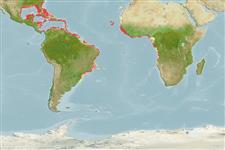Actinopterygii (ray-finned fishes) >
Perciformes (Perch-likes) >
Serranidae (Sea basses: groupers and fairy basslets) > Grammistinae
Etymology: Rypticus: Greek, ryptikos, -e, -on = easy to wash (Ref. 45335).
Environment / Climate / Range
Ecology
Marine; reef-associated; depth range 1 - 62 m (Ref. 58047), usually 2 - 35 m (Ref. 40849). Tropical, preferred ?; 33°N - 35°S, 98°W - 19°E
Western Atlantic: Bermuda and southern Florida, USA to Brazil. Eastern Atlantic: Mauritania to Angola, including St. Paul's Rocks (Ref. 13121), Cape Verde, St. Helena and Ascension islands. One record from Cape of Good Hope, South Africa (Ref. 7320).
Size / Weight / Age
Maturity: Lm ? range ? - ? cm
Max length : 35.0 cm TL male/unsexed; (Ref. 26999); common length : 25.0 cm TL male/unsexed; (Ref. 3632)
A solitary species (Ref. 26340) inhabiting shallow water on bottoms with eroded limestone or mixed sand and rocks, as well as around reefs. Often found lying motionless against rocks (Ref. 13121). Secretes copious mucus which makes its surface slimy and when disturbed the slime turns into a soapy foam. The mucus has been shown to contain a toxic protein (Ref. 3632). Nocturnal, frequently seen around the bases of coral colonies and near mouths of caves (Ref. 26938).
Life cycle and mating behavior
Maturity | Reproduction | Spawning | Eggs | Fecundity | Larvae
Robins, C.R. and G.C. Ray, 1986. A field guide to Atlantic coast fishes of North America. Houghton Mifflin Company, Boston, U.S.A. 354 p. (Ref. 7251)
IUCN Red List Status (Ref. 115185)
CITES (Ref. 94142)
Not Evaluated
Human uses
Fisheries: subsistence fisheries; aquarium: commercial
More information
ReferencesAquacultureAquaculture profileStrainsGeneticsAllele frequenciesHeritabilityDiseasesProcessingMass conversion
Tools
Special reports
Download XML
Internet sources
Estimates of some properties based on models
Phylogenetic diversity index (Ref.
82805): PD
50 = 0.5010 [Uniqueness, from 0.5 = low to 2.0 = high].
Bayesian length-weight: a=0.01148 (0.00445 - 0.02962), b=3.06 (2.84 - 3.28), in cm Total Length, based on LWR estimates for this (Sub)family-body shape (Ref.
93245).
Trophic Level (Ref.
69278): 4.1 ±0.5 se; Based on diet studies.
Resilience (Ref.
69278): Medium, minimum population doubling time 1.4 - 4.4 years (Preliminary K or Fecundity.).
Vulnerability (Ref.
59153): Low to moderate vulnerability (34 of 100) .
